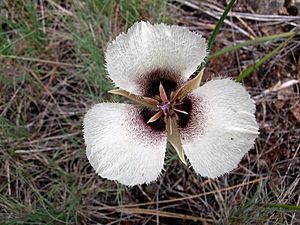Umpqua mariposa lily facts for kids
Quick facts for kids Umpqua mariposa lily |
|
|---|---|
 |
|
| Conservation status | |
| Scientific classification | |
| Genus: |
Calochortus
|
| Species: |
umpquaensis
|
The Umpqua mariposa lily (scientific name: Calochortus umpquaensis) is a beautiful flowering plant. It belongs to the lily family. This special flower is only found in Oregon, a state in the United States. It mostly grows in the Klamath Mountains, especially near the Little River in Douglas County. You can find it on mountains like Watson and Ace Williams. It has also been seen in a few spots in Josephine and Jackson Counties.
This plant was first officially described in 1989. Before that, people thought it was a different type of lily. But scientists discovered it was its own unique species!
What Does It Look Like?
The Umpqua mariposa lily has a stem that grows about 20 to 30 centimeters (8 to 12 inches) tall. It can have one or more flowers on each stem.
The flowers are shaped like bells. They have three petals that are white or cream-colored. Each petal has a fuzzy, purple-black spot at its base. These petals can grow up to 3.5 centimeters (about 1.4 inches) long. After the flower blooms, it produces a fruit that looks like a capsule. This capsule can be up to 5.4 centimeters (about 2.1 inches) long.
Where Does It Grow?
This wildflower always grows in a special type of soil called serpentine soil. This soil is found in different kinds of places, like pine forests and open grasslands. It also grows in the areas where these two habitats meet.
Serpentine soils are unique because they have high amounts of certain metals. These include nickel, cadmium, magnesium, and phosphorus.
Other plants that often grow near the Umpqua mariposa lily include:
- Jeffrey pine (Pinus jeffreyi)
- Incense cedar (Calocedrus decurrens)
- Douglas fir (Pseudotsuga menziesii)
- Hooker's silene (Silene hookeri ssp. hookeri)
- Showy tarweed (Madia elegans var. densifolia)
- Cismontane minuartia (Minuartia cismontana)
- Roemer's fescue (Festuca roemeri)
How Rare Is It?
Even though the Umpqua mariposa lily is generally rare, it can be found in large numbers in certain spots. For example, on Ace Williams Mountain, there are between 400,000 and 800,000 individual plants! This shows that while its habitat is small, it can thrive where it grows.
Protecting This Plant
There are a few things that can harm the Umpqua mariposa lily. These include:
- Nickel mining: Digging for nickel in the soil can destroy its habitat.
- New plants: Some plants that are not native to the area can move in and take over, pushing out the lily.
- Poaching: This means people illegally take the plants from their natural homes.
Other activities like logging (cutting down trees) and cattle grazing (cows eating plants) can also be a problem. However, on government-owned lands, steps have been taken recently to reduce these threats and help protect the lily.


